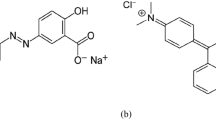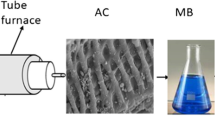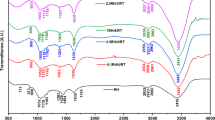Abstract
Rice husk ash and rice husk are waste materials generated in the rice agro-industries. This study focuses on the possibility of using these materials as adsorbents for the removal of reactive blue dye 19. The adsorbents were characterized by employing the point of zero charge technique, scanning electron microscopy, X-ray microanalysis, and Fourier-transform infrared spectroscopy. The adsorption study was performed in a static system and by determining the influence of the initial concentration, adsorbent dose, initial pH, contact time, and temperature effect. The conditions of the removal process were established as being an initial pH 2, an adsorbent dose of 1 g/100 mL, and an equilibrium time of 120 min. A kinetic study was performed, and the data obtained for rice husk ash as regards blue dye 19 adsorption fitted best to the Bangham model, while those obtained for RH fitted best to the pseudo-second order and Bangham models. The equilibrium isotherms were analyzed by employing the Langmuir, Freundlich, Toth, and Sips models, and the Langmuir and Toth models proved to be the best representatives of blue dye 19 adsorption for both rice husk ash and rice husk. The thermodynamics of the adsorption process was studied, showing that the rice husk/blue dye 19 and rice husk ash/blue dye 19 removal systems were spontaneous and exothermic.





Similar content being viewed by others
References
Naje AS, Chelliapan S, Zakaria Z, Ajeel MA, Alaba PA (2017) A review of electrocoagulation technology for the treatment of textile wastewater. Rev Chem Eng 33(3):263–292. https://doi.org/10.1515/revce-2016-0019
North LL, Cameron JD (2000) Grassroots-based rural development strategies: Ecuador in comparative perspective. World Dev 28(10):1751–1766. https://doi.org/10.1016/s0305-750x(00)00056-5
Schneider K, Hafner C, Jäger I (2004) Mutagenicity of textile dye products. J Appl Toxicol 24(2):83–91. https://doi.org/10.1002/jat.953
Singh Z, Chadha P (2016) Textile industry and occupational cancer. J Occup Med Toxicol 11(1):39. https://doi.org/10.1186/s12995-016-0128-3
dos Santos RMM, Gonsalves RGL, Constantino VRL, Santilli CV, Borges PD, Tronto J, Pinto FG (2017) Adsorption of acid yellow 42 dye on calcined layered double hydroxide: effect of time, concentration, pH and temperature. Appl Clay Sci 140:132–139. https://doi.org/10.1016/j.clay.2017.02.005
Gurel L (2017) Biosorption of textile dye reactive blue 221 by capia pepper (Capsicum annuum L.) seeds. Water Sci Technol 75(8):1889–1898. https://doi.org/10.2166/wst.2017.068
Berkessa YW, Yan B, Li T, Jegatheesan V, Zhang Y (2020) Treatment of anthraquinone dye textile wastewater using anaerobic dynamic membrane bioreactor: performance and microbial dynamics. Chemosphere 238:124539. https://doi.org/10.1016/j.chemosphere.2019.124539
Hethnawi A, Nassar NN, Manasrah AD, Vitale G (2017) Polyethylenimine-functionalized pyroxene nanoparticles embedded on diatomite for adsorptive removal of dye from textile wastewater in a fixed-bed column. Chem Eng J 320:389–404. https://doi.org/10.1016/j.cej.2017.03.057
Dotto J, Fagundes-Klen MR, Veit MT, Palácio SM, Bergamasco R (2019) Performance of different coagulants in the coagulation/flocculation process of textile wastewater. J Clean Prod 208:656–665. https://doi.org/10.1016/j.jclepro.2018.10.112
Verma AK, Dash RR, Bhunia P (2012) A review on chemical coagulation/flocculation technologies for removal of colour from textile wastewaters. J Environ Manag 93(1):154–168. https://doi.org/10.1016/j.jenvman.2011.09.012
Javaid R, Qazi UY (2019) Catalytic oxidation process for the degradation of synthetic dyes: an overview. Int J Environ Res Public Health 16(11):27. https://doi.org/10.3390/ijerph16112066
Thamaraiselvan C, Noel M (2015) Membrane processes for dye wastewater treatment: recent Progress in fouling control. Crit Rev Environ Sci Technol 45(10):1007–1040. https://doi.org/10.1080/10643389.2014.900242
Torres GF, Mendez JAO, Tinoco DL, Marin ED, Arana J, Herrera-Melian JA, Espino-Estevez MR, Rodrigez JMD, Pena JP (2016) Application of advanced oxidation technologies and sand filter for the detoxification of effluents from small textile industries in Ecuador. Desalin Water Treat 57(1):24288–24298. https://doi.org/10.1080/19443994.2016.1141711
Jia ZG, Li ZY, Ni T, Li SB (2017) Adsorption of low-cost absorption materials based on biomass (Cortaderia selloana flower spikes) for dye removal: kinetics, isotherms and thermodynamic studies. J Mol Liq 229:285–292. https://doi.org/10.1016/j.molliq.2016.12.059
USDA (2019) Rice outlook. United States Department of Agriculture. https://www.ers.usda.gov/webdocs/publications/93732/rcs-19h.pdf?v=9235.5
Moreno B (2015) Rendimientos de arroz en cáscara en el Ecuador, primer cuatrimestre del 2015. Ministerio de Agricultura, Ganadería, Acuacultura y Pesca, Quito
Chowdhury S, Mishra R, Saha P, Kushwaha P (2011) Adsorption thermodynamics, kinetics and isosteric heat of adsorption of malachite green onto chemically modified rice husk. Desalination 265(1):159–168. https://doi.org/10.1016/j.desal.2010.07.047
Ahmaruzzaman M, Gupta VK (2011) Rice husk and its ash as low-cost adsorbents in water and wastewater treatment. Ind Eng Chem Res 50(24):13589–13613. https://doi.org/10.1021/ie201477c
Sharma P, Kaur R, Baskar C, Chung W-J (2010) Removal of methylene blue from aqueous waste using rice husk and rice husk ash. Desalination 259(1):249–257. https://doi.org/10.1016/j.desal.2010.03.044
Naseer R, Afzal N, Zulfiqar-Ul H, Saeed S, Mujhahid H, Faryal S, Aslam S, Habib-Ur R (2020) Effect of bronsted base on topological alteration of rice husk as an efficient adsorbent comparative to rice husk ash for azo dyes. Pol J Environ Stud 29(4):2795–2802. https://doi.org/10.15244/pjoes/112353
Mishra A, Clark JH, Kraus GA, Seidl PR, Stankiewicz A (2013) Green materials for sustainable water remediation and treatment. Royal Society of Chemistry
Campos NF, Barbosa C, Rodriguez-Diaz JM, Duarte M (2018) Removal of naphthenic acids using activated charcoal: kinetic and equilibrium studies. Adsorpt Sci Technol 36(7–8):1405–1421. https://doi.org/10.1177/0263617418773844
Xie A, Dai J, Chen X, He J, Chang Z, Yan Y, Li C (2016) Hierarchical porous carbon materials derived from a waste paper towel with ultrafast and ultrahigh performance for adsorption of tetracycline. RSC Adv 6(77):72985–72998. https://doi.org/10.1039/C6RA17286E
Andrade CA, Zambrano-Intriago LA, Oliveira NS, Vieira JS, Quiroz-Fernández LS, Rodríguez-Díaz JM (2020) Adsorption behavior and mechanism of oxytetracycline on rice husk ash: kinetics, equilibrium, and thermodynamics of the process. Water Air Soil Pollut 231(3). https://doi.org/10.1007/s11270-020-04473-6
Ebrahimian Pirbazari A, Fakhari Kisom B, Ghamangiz Khararoodi M (2016) Anionic surfactant-modified rice straw for removal of methylene blue from aqueous solution. Desalin Water Treat 57(39):18202–18216. https://doi.org/10.1080/19443994.2015.1090919
Rodriguez-Diaz JM, Garcia JOP, Sanchez LRB, da Silva MG, da Silva VL, Arteaga-Perez LE (2015) Comprehensive characterization of sugarcane bagasse ash for its use as an adsorbent. BioEnergy Res 8(4):1885–1895. https://doi.org/10.1007/s12155-015-9646-6
Fávaro SL, Lopes MS, Vieira de Carvalho Neto AG, Rogério de Santana R, Radovanovic E (2010) Chemical, morphological, and mechanical analysis of rice husk/post-consumer polyethylene composites. Compos A: Appl Sci Manuf 41(1):154–160. https://doi.org/10.1016/j.compositesa.2009.09.021
Genieva S, Turmanova S, Dimitrova A, Vlaev L (2008) Characterization of rice husks and the products of its thermal degradation in air or nitrogen atmosphere. J Therm Anal Calorim 93(2):387–396
Lakshmi UR, Srivastava VC, Mall ID, Lataye DH (2009) Rice husk ash as an effective adsorbent: evaluation of adsorptive characteristics for indigo carmine dye. J Environ Manag 90(2):710–720. https://doi.org/10.1016/j.jenvman.2008.01.002
Firdaus MYN, Osman H, Metselaar HS, Rozyanty AR (2016) Preparation and characterization of active SiO2 from Cymbopogon citratus ash calcined at different temperature. BioResources 11(1):2839–2849
Srivastava VC, Mall ID, Mishra IM (2006) Characterization of mesoporous rice husk ash (RHA) and adsorption kinetics of metal ions from aqueous solution onto RHA. J Hazard Mater 134(1–3):257–267. https://doi.org/10.1016/j.jhazmat.2005.11.052
Riyap HI, Bewa CN, Banenzoué C, Tchakouté HK, Rüscher CH, Kamseu E, Bignozzi MC, Leonelli C (2019) Microstructure and mechanical, physical and structural properties of sustainable lightweight metakaolin-based geopolymer cements and mortars employing rice husk. J Asian Ceram Soc 7(2):199–212. https://doi.org/10.1080/21870764.2019.1606140
Zou WH, Li K, Bai HJ, Shi XL, Han RP (2011) Enhanced cationic dyes removal from aqueous solution by oxalic acid modified rice husk. J Chem Eng Data 56(5):1882–1891. https://doi.org/10.1021/je100893h
Lagergren S (1898) About the theory of so-called adsorption of soluble substances. Sven Vetenskapsakad Handingarl 24:1–39
Ho YS, McKay G (1999) Pseudo-second order model for sorption processes. Process Biochem 34(5):451–465. https://doi.org/10.1016/S0032-9592(98)00112-5
Bangham DH, Burt FP (1924) The behaviour of gases in contact with glass surfaces. Proc R soc Lond Ser A-Contain Pap Math Phys Charact 105(732):481–488. https://doi.org/10.1098/rspa.1924.0032
Weber WJ, Morris JC (1963) Kinetics of adsorption on carbon from solution. J Sanit Eng Div 89(2):31–60
Kaykioğlu G, Güneş E (2015) Kinetic and equilibrium study of methylene blue adsorption using H2SO4− activated rice husk ash. Desalin Water Treat 57(15):7085–7097. https://doi.org/10.1080/19443994.2015.1014859
Shanker M, Chinniagounder T (2012) Adsorption of reactive dye using low cost adsorbent: cocoa (Theobroma Cacao) Shell. World J Appl Environ Chem 1(1):22–29
Mane VS, Mall ID, Srivastava VC (2007) Use of bagasse fly ash as an adsorbent for the removal of brilliant green dye from aqueous solution. Dyes Pigments 73(3):269–278. https://doi.org/10.1016/j.dyepig.2005.12.006
Wu F-C, Tseng R-L, Juang R-S (2009) Initial behavior of intraparticle diffusion model used in the description of adsorption kinetics. Chem Eng J 153(1):1–8. https://doi.org/10.1016/j.cej.2009.04.042
Dahri MK, Kooh MRR, Lim LBL (2014) Water remediation using low cost adsorbent walnut shell for removal of malachite green: equilibrium, kinetics, thermodynamic and regeneration studies. J Environ Chem Eng 2(3):1434–1444. https://doi.org/10.1016/j.jece.2014.07.008
Mezenner NY, Bensmaili A (2009) Kinetics and thermodynamic study of phosphate adsorption on iron hydroxide-eggshell waste. Chem Eng J 147(2–3):87–96. https://doi.org/10.1016/j.cej.2008.06.024
Langmuir I (1918) The adsorption of gases on plane surfaces of glass, mica and platinum. J Am Chem Soc 40(9):1361–1403. https://doi.org/10.1021/ja02242a004
Freundlich H (1906) Adsorption in solution Phys. In: Chem Soc, pp 1361–1368
Toth J (1971) State equation of the solid-gas interface layers. Model Chem 69:311–328
Sips R (1948) Combined form of Langmuir and Freundlich equations. J Chem Phys 16(429):490–495
Srivastava VC, Mall ID, Mishra IM (2007) Adsorption thermodynamics and isosteric heat of adsorption of toxic metal ions onto bagasse fly ash (BFA) and rice husk ash (RHA). Chem Eng J 132(1–3):267–278. https://doi.org/10.1016/j.cej.2007.01.007
Ho YS, Porter JF, McKay G (2002) Equilibrium isotherm studies for the sorption of divalent metal ions onto peat: copper, nickel and lead single component systems. Water Air Soil Pollut 141(1):1–33. https://doi.org/10.1023/A:1021304828010
Perez-Marin AB, Zapata VM, Ortuno JF, Aguilar M, Saez J, Llorens M (2007) Removal of cadmium from aqueous solutions by adsorption onto orange waste. J Hazard Mater 139(1):122–131. https://doi.org/10.1016/j.jhazmat.2006.06.008
Fawzy MA, Gomaa M (2020) Use of algal biorefinery waste and waste office paper in the development of xerogels: a low cost and eco-friendly biosorbent for the effective removal of Congo red and Fe (II) from aqueous solutions. J Environ Manag 262:110380. https://doi.org/10.1016/j.jenvman.2020.110380
MacQueen JT (1967) Some observations concerning the van't Hoff equation. J Chem Educ 44(12):755. https://doi.org/10.1021/ed044p755
Ghosh A, Das G (2020) Green synthesis of Sn(II)-BDC MOF: preferential and efficient adsorption of anionic dyes. Microporous Mesoporous Mater 297:110039. https://doi.org/10.1016/j.micromeso.2020.110039
Acknowledgments
The authors would like to thank the Laboratory of the Centro de Materiais da Universidade do Porto (CEMUP), Innovation and Development Area of La Fabril, Laboratório de Engenharia e Processos Ambientais (LEPA) and Laboratório de Engenharia Ambiental (LEA), for their help in the adsorbent characterization and the scanning electron microscopy, X-ray, and FTIR analyses and to the company Espectrocrom, especially in memory of the Engineer Edmundo Regalado by his unconditional support.
Funding
To the Universidad Técnica de Manabí for financing the Project “Evaluation of the use of biomass for the remediation of environmental pollutants by the Technical University of Manabí” PYT235-CONV2019-FCMFQ0018.
Author information
Authors and Affiliations
Corresponding author
Ethics declarations
Conflict of interest
The authors declare that they have no conflicts of interest.
Additional information
Publisher’s note
Springer Nature remains neutral with regard to jurisdictional claims in published maps and institutional affiliations.
Electronic supplementary material
ESM 1
(DOCX 1149 kb)
Rights and permissions
About this article
Cite this article
Zambrano-Intriago, L.A., Gorozabel-Mendoza, M.L., Córdova Mosquera, A. et al. Kinetics, equilibrium, and thermodynamics of the blue 19 dye adsorption process using residual biomass attained from rice cultivation. Biomass Conv. Bioref. 12, 3843–3855 (2022). https://doi.org/10.1007/s13399-020-00944-2
Received:
Revised:
Accepted:
Published:
Issue Date:
DOI: https://doi.org/10.1007/s13399-020-00944-2




